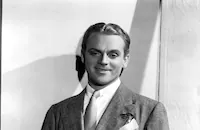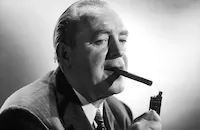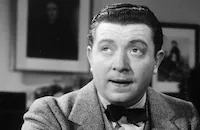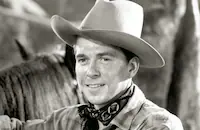Boy Meets Girl

Brief Synopsis
Cast & Crew
Lloyd Bacon
James Cagney
Pat O'brien
Marie Wilson
Ralph Bellamy
Frank Mchugh
Film Details
Technical Specs

Synopsis
Robert Law and J. C. Benson, two Hollywood screenwriters, are assigned to write a story for cowboy star, Larry Toms, but nothing they write pleases producer C. Elliott Friday. While they argue, Susie, a divorced waitress, delivers lunch. Inspired by her pregnancy, Benson and Law suggest they do a western in which Larry finds a lone baby in a variation on the classic Hollywood story: Boy Meets Girl, Boy Loses Girl, Boy Gets Girl. Larry protests, but the producer likes the idea, and they all rush from the room to take the idea to the top, leaving Susie alone. Rodney Bevan, an English actor, arrives to wait for Friday's return. He and Susie talk and flirt a little, but the conversation ends when the writers return. Benson and Law suggest that they sign Susie's soon-to-be-born baby, Happy, to a contract, which will place them, as his godfathers, in control. Happy's success allows Susie to attend high school, her secret ambition. Because of Happy's popularity, Larry's agent encourages him to marry Susie, but Law breaks up their engagement by having Rodney claim to be Happy's father. Back at the studio, Susie announces that Happy has come down with the measles and, as they soon find out, has given them to Larry. While they recover, Benson, Law and Happy are all fired. Benson and Law scheme successfully to get Friday to re-sign Happy and fire Larry. Then Rodney bursts into Friday's office to ask Susie to marry him. She refuses at first, because of her bad luck with her first marriage, but finally she agrees. Friday is furious because Rodney, the son of an English lord, wants to take Happy to England, but when he learns that his own wife is pregnant, he realizes that Happy's replacement is on the way.

Director

Lloyd Bacon
Cast

James Cagney

Pat O'brien

Marie Wilson

Ralph Bellamy

Frank Mchugh

Dick Foran
Bruce Lester

Ronald Reagan
Paul Clark

Penny Singleton
Dennie Moore
Harry Seymour
Bert Hanlon

James Stephenson
Bill Telaak
Vera Lewis
Jan Holm

Rosella Towne
Dorothy Vaughan
Loia Cheaney
Nanette Lafayette
Peggy Moran
Eddy Conrad

Pierre Watkin

John Ridgely
George Hickman
Cliff Saum

Carole Landis

Curt Bois
Janet Shaw
Otto Fries
John Harron
Hal K. Dawson
Bert Howard
James Nolan
Crew
George Abbott
Milo Anderson
Sam Bischoff
Leo F. Forbstein
Esdras Hartley
William Holmes
M. K. Jerome
Dick Mayberry
Sol Polito
Jack Scholl
Bella Spewack
Samuel Spewack
Dolph Thomas
Jack L. Warner

Videos
Movie Clip


Trailer
Film Details
Technical Specs

Articles
Boy Meets Girl
Several Warner newcomers are also showcased in Boy Meets Girl. Ronald Reagan, who was by self-admission "a still worshiping movie fan" at this point in his career, appears as the announcer at the movie premiere. Penny Singleton, who made a few films for Warners before moving to Columbia to star in the Blondie series, plays the manicurist (she was later the voice for Jane Jetson in the animated series, The Jetsons). And Carole Landis turns up as the commissary cashier. There's also Marie Wilson, who got her start in the Laurel and Hardy vehicle Babes in Toyland (1934), as Susie.
The role of Susie was originally intended for Marion Davies. There are several accounts as to why Davies, the longtime mistress of newspaper magnate William Randolph Hearst, did not appear in the film. Some say Hearst objected to Davies playing Susie ? a pregnant (and husbandless) waitress. Others cite the timing of Hearst pulling his financially strapped Cosmopolitan Pictures off the Warners lot. While other accounts claim Davies was displeased with casting changes (the comedy team of Olsen & Johnson were originally to have played the screenwriting team portrayed by the less comedic Cagney and O'Brien) and by the size of her role. The part of Susie was reduced even further after Davies was replaced by Marie Wilson. Regardless of the reason, Davies never made another film. Ever Since Eve (1937) would stand as her Hollywood swansong.
Boy Meets Girl was based on the hit Broadway play by Sam and Bella Spewack. The characters played by Cagney and O'Brien on film were supposedly based on real life screenwriters Ben Hecht and Charles MacArthur. And it's been suggested Bellamy's part as Studio Supervisor was based on Fox's Darryl Zanuck. Sam and Bella Spewack would go on to great success penning the screenplay for My Favorite Wife (1940) and the book for the musical Kiss Me Kate (for which they would also win the Tony Award), but the film version of Boy Meets Girl failed to live up to its stage popularity.
Cagney for one thought the film's pacing was too fast. After screening rushes one day, he reportedly said to Bellamy, "would you tell me what I just said? I couldn't understand a word." It was evidently a moment in his career that Cagney never forgot. In his autobiography Cagney by Cagney, he discussed the filming of Boy Meets Girl. "Pat and I were harassed by the producer's insistence on more speed," recalls Cagney. "So Pat and I went mostly our own ways; we were fast when we needed to be, and let air into it as required. In a farce you've got to give the audience a chance to get their breath." Cagney also brought up Boy Mets Girl twenty-three years later when tackling another comedy, One, Two, Three (1961). This time, director Billy Wilder put Cagney's fears to rest, assuring him the pacing wouldn't be too fast at the expense of dialogue. Funnily enough, Cagney apparently never saw Boy Meets Girl until years later on TV ? and he found it much better than he remembered.
Boy Meets Girl made good use of Warners sound stages, back lots and front offices, so it's an interesting behind-the-scenes look at the studio. Also, for an inside joke, check out the marquee behind Ronald Reagan at the film premiere. The film's title is The White Rajah. This was the name of a script penned by Errol Flynn years earlier which was deemed too weak to film. Lloyd Bacon came across the script while looking for a title for Boy Meets Girl's fictional film premiere. Flynn was reportedly not amused.
Producer: Samuel Bischoff, Hal B. Wallis, Jack L. Warner
Director: Lloyd Bacon
Screenplay: Bella Spewack, Sam Spewack
Cinematography: Sol Polito
Editing: William Holmes
Music: M.K. Jerome, Jack Scholl, Harry Warren
Art Direction: Esdras Hartler
Cast: James Cagney (Robert Law), Pat O'Brien (J. Carlyle 'J.C.' Benson), Marie Wilson (Susie Seabrook), Penny Singleton (Peggie), Ralph Bellamy (C.F. Friday), Frank McHugh (Rossetti), Dick Foran (Larry Toms), Ronald Reagan (Radio announcer), James Stephenson (Major Thompson).
BW-86m. Closed Captioning.
by Stephanie Thames

Boy Meets Girl
Ronald Reagan, 1911-2004 - TCM Remembers Ronald Reagan
Ronald Reagan, the actor turned elected official whose fascinating career saw him develop as a contract player for Warner Brothers studios, to a politician who fulfilled his ambitions by becoming the 40th President of the United States, died at his home in Los Angeles on June 5 after a long battle with Alzheimer's disease. He was 93.
He was born Ronald Wilson Reagan on February 6, 1911 in Tampico, Illinois to John and Nelle Reagan. When Reagan was nine, his family settled down in the small community of Dixon, about 100 miles west of Chicago. After high school, Reagan enrolled in Eureka College, a small Christian school near Peoria. He graduated in 1932 with a degree in Economics, and pursued a career in broadcasting. His first gig was as a part-time announcer at WOC in Davenport, Iowa. Within a year, WOC had merged with its big-sister station, WHO in Des Moines, and Reagan was hired as a sports announcer.
In the spring of 1937, Reagan drove to Southern California to catch the Chicago Cubs in spring training on Santa Catalina Island. While he was in California, he wrangled a screen test and signed a contract for $200 a week with Warner Brothers. His film debut was rather inauspicious; he portrayed a radio announcer in an innocuous comedy Love is on the Air (1937). He made a few more "B" programmers like Hollywood Hotel (also 1937), and Girls on Probation (1938), before getting his first prominent role opposite Bette Davis in the popular tearjerker, Dark Victory (1939).
Although he seldom got credit for being a good actor, there was no denying that Reagan held his own given the right material: Knute Rockne, All American as the doomed Notre Dame football hero George "The Gipper" Gipp, where he delivered the film's immortal line "Win one for the Gipper!"; Santa Fe Trail in which he ably supports Errol Flynn in one of the boxoffice hits of its era (both 1940); Kings Row (1941), featuring one of his finest performances as a small-town playboy whose legs are amputated by a careless surgeon; and Desperate Journey (1942) where he again supported Flynn in an exciting action picture.
Due to his poor eyesight, Reagan didn't see any action in World War II, so the studio heads assigned him to star in a series of patriotic films produced by the First Motion Picture Unit of the Army Air Forces in Culver City. Between 1942-45, Reagan starred in over 400 of these films. After the war, Reagan still found some good roles: The Voice of the Turtle (1947) proved he had a deft hand at light comedy opposite Eleanor Parker; The Hasty Heart (1949) offered another underrated performance as he ably portrayed the Yank in John Patrick's much heralded wartime play; and Storm Warning (1950) was a slick melodrama that cast Reagan as a crusading District Attorney determined to bring the KKK in a small southern town, with the help of Doris Day and Ginger Rogers!
It was around this time that Reagan became involved in politics. In 1947, he began a five-year term as president of the Screen Actors Guild (SAG), and testified in October of that year before the newly formed House Un-American Activities Committee (HUAC). He identified suspected Communists Larry Parks, Howard Da Silva and Alexander Knox, all of whom were subsequently called to testify, and subsequently blacklisted. Later records showed Reagan was so concerned about the Communist influence in Hollywood, that he became an FBI informer.
As Reagan became steeped in his political career, his parts throughout the '50s became inferior: the notorious Bedtime for Bonzo (1951); the coy "sex" comedy She's Working Her Way Through College (1952) that cast him as a college professor who romances a stripper! (Virginia Mayo); Cattle Queen of Montana (1955), a sluggish Western that even the redoubtable Barbara Stanwyck couldn't save; and finally Hellcats of the Navy (1957), a stodgy war picture that would be his only film that co-starred his wife Nancy (Davis).
Television offered some salvation. For eight years, (1954-62), Reagan served as the host of General Electric Theater, a televised series of dramas. He also found a niche as GE's goodwill ambassador to employees and to civic and business groups around the country, furthering his taste and honing his craft as a public official. By the mid '60s, Reagan would move into politics entirely, save for one last film, the thrilling The Killers (1964), Reagan's only known villainous role, as a murderous gangster. That same year, he actively campaigned for Republican Presidential candidate Barry Goldwater, although Goldwater lost to Lyndon B. Johnson.
Reagan whose profile was riding high, had cemented his future as a successful politician. In 1966, he ran against incumbent Governor Pat Brown for the state of California and won, serving successfully for two terms until 1974.
Reagan began an all-out, two-year drive to wrest the 1976 nomination from incumbent Gerald R. Ford, an appointed vice president who became president on the resignation of Nixon. Reagan fell short by a handful of delegates to the Republican national convention. But Ford lost to Jimmy Carter, and Reagan became the front-runner to challenge Carter in 1980. After defeating Carter, Reagan held two terms as President of the United States (1981-89). After his second term was over, he retired quietly in California. In 1994, it was revealed to the media that Reagan was suffering from Alzheimer's disease; he had been kept out of the public eye since then.
He was married briefly to actress Jane Wyman (1940-48), and had two children; a daughter Maureen and an adopted son, Michael. In 1952, he married a budding film starlet, Nancy Davis, who bore him two more children; a daughter, Patty; and a son, Ronald Jr. Ronald Reagan is survived by Nancy, Michael, Patty and Ron Jr. His daughter Maureen died of Melanoma in 2001 at the age of 60.
by Michael T. Toole
Ronald Reagan, 1911-2004 - TCM Remembers Ronald Reagan
Quotes
Trivia
Notes
Bella and Samuel Spewack received the 1936 Roi Cooper Megrue Award for their play Boy Meets Girl. The play was revived on June 22, 1943. Contemporary reviews agreed that censorship requirements made the satire in the movie less successful than in the stage version, specifically citing the character of Susie, who was unwed in the play. According to Hollywood Reporter, Marion Davies was considered for the lead, but modern sources say that William Randolph Hearst thought the script was too racy for the image he felt she should maintain.

Miscellaneous Notes
Released in United States Summer August 27, 1938
b&w
Released in United States Summer August 27, 1938














